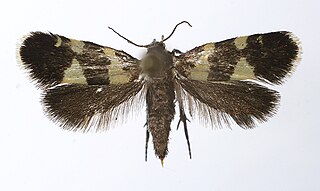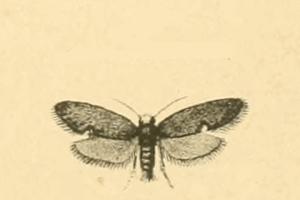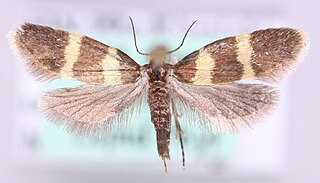The Prodoxidae are a family of moths, generally small in size and nondescript in appearance. They include species of moderate pest status, such as the currant shoot borer, and others of considerable ecological and evolutionary interest, such as various species of "yucca moths".

Tambja morosa, also known as Tambja kushimotoensis or gloomy nudibranch, is a species of sea slug, a dorid nudibranch, a shell-less marine gastropod mollusk in the subfamily Nembrothinae within the family Polyceridae.

Lampronia luzella is a moth of the family Prodoxidae. It is found in Ireland, Great Britain, the Benelux, France, central Europe, Italy, Fennoscandia, the Baltic region, Russia, Poland, the Czech Republic and Romania.

The currant shoot borer moth is a species of moth of the family Prodoxidae. It is found in most of central, northern and eastern Europe. It is also found in North America.

Lampronia aeripennella is a moth of the family Prodoxidae. It is found in Sweden, Finland, France, Austria, Italy and Romania.

Lampronia is a genus of moths of the family Prodoxidae.
Lampronia argillella is a moth of the family Prodoxidae. It is found in Austria, Slovakia and the Caucasus.
Lampronia intermediella is a moth of the family Prodoxidae. It is found in Slovakia and Romania.

Lampronia provectella is a moth of the family Prodoxidae. It is found in France, Germany, Switzerland, Austria, Poland, the Czech Republic, Slovakia and Romania. It is also present in Russia east to the Altai Mountains.

Lampronia redimitella is a moth of the family Prodoxidae. It is found in Fennoscandia, the Baltic region, Poland, the Czech Republic and Germany.
Lampronia stangei is a moth of the family Prodoxidae. It is found in Italy.
Lampronia altaica is a moth of the family Prodoxidae. It is found in the Altai Mountains of central Asia, the Ryanggang Province of North Korea and in Japan.
Lampronia oregonella is a moth of the family Prodoxidae. In North America it is found in British Columbia, Washington, Oregon and Colorado.
Lampronia russatella is a moth of the family Prodoxidae. It is found in mesic forests in eastern North America.
Lampronia taylorella is a moth of the family Prodoxidae. In North America it is found along the coast of British Columbia and in Washington and Montana.
Lampronia sakhalinella is a moth of the family Prodoxidae. It is found on the Sakhalin peninsula in Russia.
Lampronia humilis is a moth of the family Prodoxidae. In North America it is found in the coastal areas of British Columbia south to northern California.
Lampronia sublustris is a moth of the family Prodoxidae first described by Annette Frances Braun in 1925. In North America it is found from southern British Columbia south to northern California and east to Alberta, Utah and Colorado.

Neptis morosa, the savanna sailer or morose sailer, is a butterfly in the family Nymphalidae. It is found in Senegal, Guinea, Sierra Leone, Ivory Coast, Ghana, Togo, Benin, Nigeria, Cameroon, Gabon, the Republic of the Congo, the Central African Republic, Angola, the eastern part of the Democratic Republic of the Congo, Uganda, Burundi, western Kenya and north-western Tanzania. The habitat consists of moist areas and forest margins.

Deinypena morosa is a moth of the family Noctuidae. It is found in the Democratic Republic of Congo.








